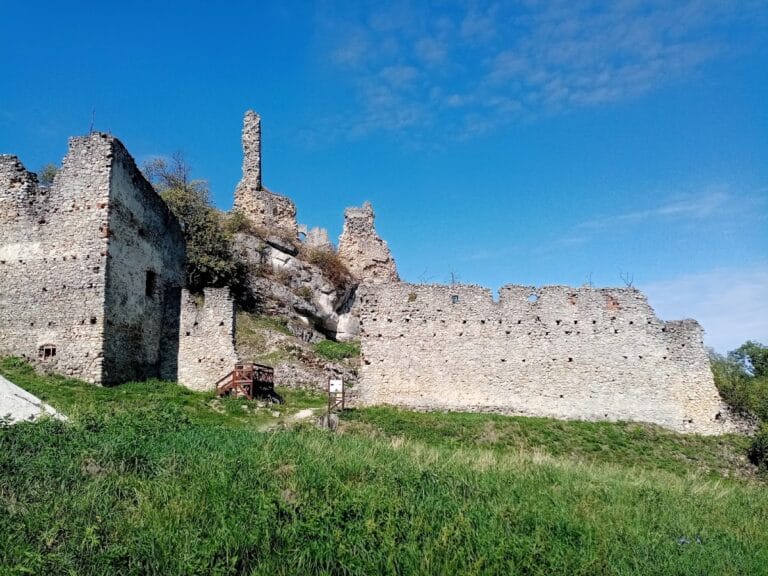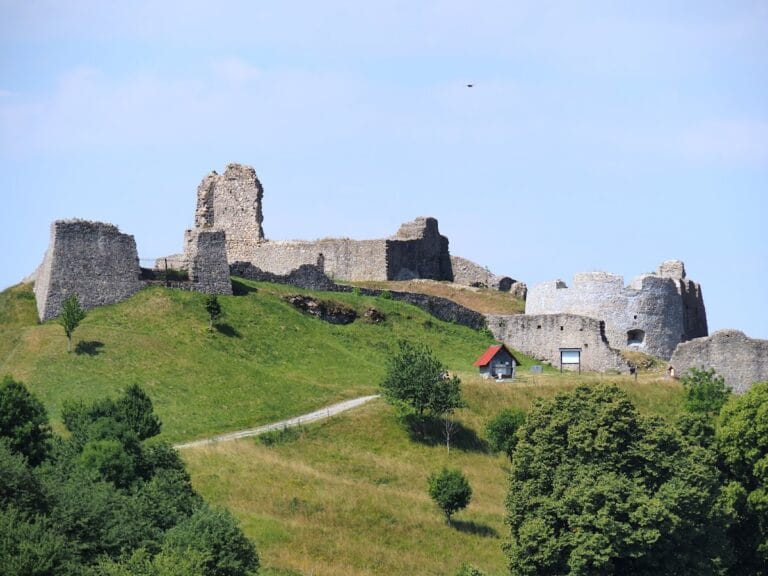Ostrý Kameň Castle: A Medieval Fortress in Slovakia
Visitor Information
Google Rating: 4.8
Popularity: Low
Google Maps: View on Google Maps
Official Website: www.planetslovakia.sk
Country: Slovakia
Civilization: Medieval European
Remains: Military
History
Ostrý Kameň Castle is located in the municipality of Buková, Slovakia, and was originally built by medieval Hungarian rulers in the 13th century. Its construction responded to the need for a royal fortress safeguarding the western border of the Kingdom of Hungary and overseeing a crucial medieval trade route known as the Czech Road, which linked Buda and Prague through the Little Carpathians.
The castle first appears in written records in 1273. Initially held as royal property, it remained under the crown’s control until 1366, when King granted it to Mikuláš of Seč. This transfer marked the beginning of the castle’s ownership by various Hungarian noble families rather than the monarchy. In the late 14th century, King Sigismund bestowed the fortress upon Stibor of Stiboricz, a prominent nobleman of his time. Over the following centuries, the castle changed hands several times among influential families including the Kegelevič, Thurzó, and Forgáč lineages. From the 15th century, counts from Svätý Jur and Pezinok also became part-owners.
In the 16th century, the Czobor family managed the estate, though from 1554 onwards, ownership was divided into quarters shared by the Bakič and Révay families after a lengthy legal dispute resolved under the authority of Emperor Charles V. The castle’s military role diminished after a battle during the Kuruc uprising in 1704, which caused damage to its structure. Following this event, the Czech Road was redirected via Bratislava, greatly reducing the castle’s strategic importance.
By the late 18th century, the Pálffy family had inherited the estate and shifted the administrative center to Moravský Svätý Ján. This relocation led to the castle being abandoned and gradually falling into ruin. Its decline was further hastened by repeated quarrels over ownership and the appearance of bandits in the region during that period.
Remains
Ostrý Kameň Castle is positioned on the steep limestone ridge of Zárub, the highest point in the Little Carpathians, standing at 576 meters above sea level. The name “Ostrý Kameň,” meaning “Sharp Stone,” reflects the jagged profile of the rock on which the fortress was built. The original medieval design featured an elongated residential palace connected to a rectangular defensive tower set at the ridge’s summit. This tower served as an observation point with views reaching other regional castles such as Plavecký hrad, Korlátka, and Branč. Natural cliffs bordered the site, and a moat carved directly from the rock separated the defensive sections from the rest of the ridge.
During the mid-15th century, the fortress underwent expansion to the northwest. A substantial forecourt was added, which included essential service buildings like a bakery, vaulted storage rooms for supplies, a forge, and quarters for the castle’s personnel. This arrangement reflected the growing complexity of the castle’s operations as both a stronghold and an economic hub.
In response to increasing threats from Ottoman incursions in the 16th century, the castle’s defenses were further strengthened. A second forecourt featuring a round corner bastion was constructed, accompanied by additional forecastles—outer defensive structures designed to improve protection. High stone walls with corner bastions enveloped the complex, while a neck moat, locally known as Šijová priekopa, protected the most vulnerable area against attackers.
Inside the upper castle, several functional spaces have been identified. These included a water cistern for storing rainwater, a kitchen area, prison cells, and a chapel, underscoring the castle’s role as a self-contained community. Remaining architectural details reveal Renaissance influences, such as a double console (a supporting stone feature), a key-shaped embrasure—a small firing opening designed for archers or firearm use—and distinctive side window jambs.
Today, only fragments of walls belonging to three bastions survive. Over time, the ruins have become enveloped by dense forest vegetation, which accelerates the erosion of the masonry. The stonework of the castle is notably integrated with the uneven limestone bedrock, and the surviving ruins include traces of the residential, defensive, and economic parts of the fortress. Despite the deterioration, these remains continue to convey the castle’s historical complexity and original purpose.







